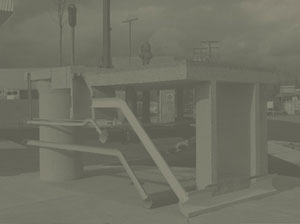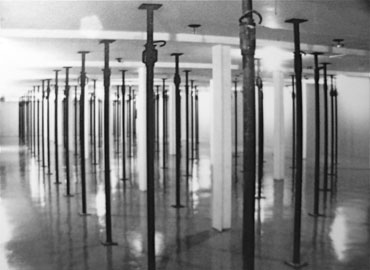The recession of the early 80's in BC resulted in severe economic cutbacks to universities and other cultural institutions, initiated by the Social Credit government. In 1984 the administration of SFU proposed substantial cuts (33%) to operating budgets for the Centre for the Arts, which, if carried through, would have meant the elimination of the department. This work was made in response to these events.
SUPPORT FOR CULTURE
An Installation at the UBC Fine Arts Gallery, February 19 - March 16, 1985
I assume people go to galleries to see what they imagine to be art, and that that art embodies characteristics which they recognize. Among their expectations are ideas about things and how they should look, what happens between an art object and the person looking has been the source of endless speculation. What is generally conceded is that in the work 'working' an exchange takes place that is usually one of recognition, if not of a familiarity, at least of a condition that informs the looking. It is also implied that this exchange is useful; that it gives you something you can use. This transaction takes place in the mind and body; that is to say it is as much about ideas as it is about perception. In this present arrangement of things in the Fine Arts Gallery, the things themselves, while embodying an aesthetic value, would commonly be held to have none, as they are presented for what they are and do: steel jacks used as temporary support for concrete in construction. While the meaning of the work does not reside solely in an aesthetic consideration of these things, they become the instruments of a broader context for meaning that encompasses the viewer. They have been arranged in the gallery according to the existent plan of the steel supports for the building itself, the Main Library of the University of British Columbia.
This room is no different from the bookstacks in the rest of the building. As such, it contains bound information systematically arranged. Like other objects of our consumption and possession which we normally construe as containers of culture, this room now contains information that is similarly transmitted through our custodianship and conservation. In the gallery, we are presented with a social idea of the use of things, their instrumentality. This situation is heuristic, serving to promote further investigation. Our experience in culture is central to that enquiry, for here the work has been turned back on us to decide for ourselves whether contemplation of a condition that speaks to us about use and acknowledgment of fact is any different from the art of the object. Compared to this art of circumstance is the the thing that embodies the autographic expression of a human experience, automatically valid and unique. In what resides our reflection on culture or on history?
Greg Snider
February, 1985




1981-2000

Hypostyle: Support for Culture
1985, concrete forming jacks 7.5' x 34.5' x 85'
1985, concrete forming jacks 7.5' x 34.5' x 85'
gregsnider.ca Copyright © 2007 - Greg Snider.
All Rights Reserved. contact: greg@gregsnider.ca
